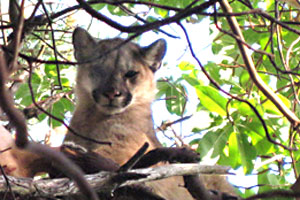It's amazing that such large animals can live so near to urban areas and remain unseen – particularly since these animals inspire such fear and alarm whenever there is a reported sighting.
In a UC Davis study in Southern California, researchers found that humans and cougars live in close proximity to each other and often cover the same territory. And in Pacific Grove, near Monterey, cougars have been seen by police officers late at night on city streets.
In one unique incident in the Big Sur area, south of Monterey, a woman thought her dog was chewing something under her bed late one night. She shooed the animal out, smacked it on the rear end, and made it leave her bedroom – only to see a full-grown cougar stare back at her from her doorway.
These incidents are extremely rare. According to the California Department of Fish and Game, there have only been 14 mountain lion attacks in the past century. Most people don't see mountain lions. And in fact, wildlife officials say, almost all of the reported sightings of cougars are actually something else – dogs, bobcats, even deer. There was a report last year of a jogger in the Palo Alto hills being knocked over by a cougar, but that report was likely fabricated. Humans might have a chance to spot a mountain lion only around dawn and dusk, officials say, and usually in remote areas at those times.

